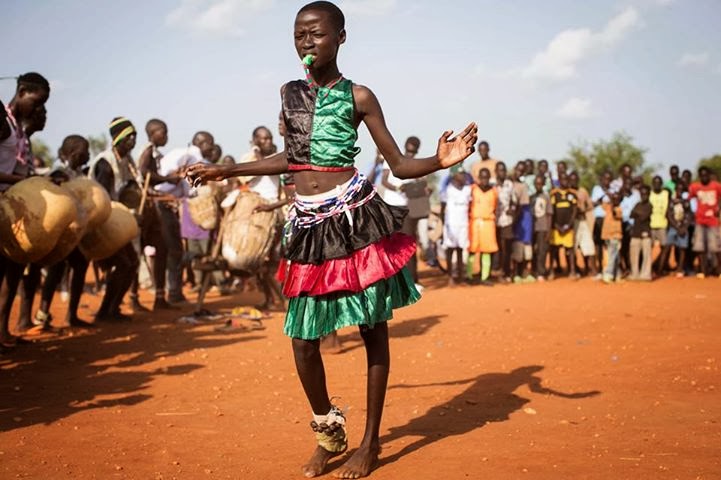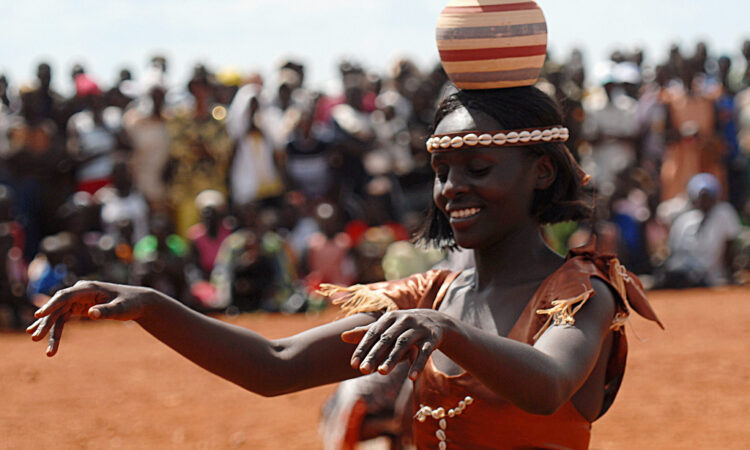The Ugandan Langi Tribe and Their Culture
The Ugandan Langi Tribe and Their CultureThe Langi people reside in the region of north central Uganda, north of Lake Kyoga. Amolatar, Dokolo, Lira, Oyam, Alebtong, Kole, and Apac make up the Lango sub-region. Luo, one of the sub-Nilo-Saharan languages, is spoken by them. They are precise with each other and the Acholi and Kumam. They share a relationship with other Kenyan luo languages. Here in Uganda, they are recognized by their rhinoceros tribal insignia.

ORIGIN
It is believed that the Langi migrated from Ethiopia between 1600 and 1700 AD. After splitting into two groups, one of them settled in Kenya and Tanzania, where they became the Kalenjin and Masai people. Other groups include the Ateker, who entered Uganda through the northeast. They relocated to Western Uganda. The Ateker then divided into four factions: the Kumam, the Itesots, the Karamojongs, and the Langi.
The Langi kept traveling westward till they came across the Acholi. While traveling, they also embraced the Acholi way of life. This is the point at when the Langi adopted the Acholi way of life and lost the Ateker method. The Acholi were driven northward toward Lake Kyoga by them. They encountered them even more as a result of this.
It is stated that the mountains Otukei and Atwi are the origin of the Langi. It’s said that these mountains receive an abundance of rain.
Similar traits are shared by the Langi and the Ateker, who are Eastern Nilotics.
The last wave of Ethiopian migrants from Abyssinia were known as the Langi. The term EKAR NGIMOJONG, which the Jie, a single group from Ararat, used to refer to themselves, meaning “the old can walk no further,” hence the derivation of the name Karamojong. They split up into multiple groups as they crossed the Kenyan-Ethiopian border in;
the Turkana people of Kenya who have settled along the border between Ethiopia and Kenya today.
Apule was the settlement of the Toposa People who migrated to Sudan Dodoth. It is a portion of Karamoja’s northern region.
After traveling south to Jie Territoy, the main party divided into three smaller groups. The Jie settled down where they did, but the Pian, Matheniko, and Bokora are the other three groups. These three groups went southward, while the third group created the Iteso, Kumam, and Langi, moving westward.
These final Pian, Bokora, and Matheniko clans traveled the farthest and are still presently residing in the Karamoja area. The Kumam people speak Luo dialect and reside in Kaberamido, whereas the Itesots are found in the Teso region. Their migration in history was this.
SETTLEMENT POLITICAL
They were extremely well-organized, with a hierarchy extending from the head of the organization to the bottom. They had the following leaders, for instance:
Home of homsteads was called Won Poco; Home of family lineage was called Awi Otem; Paramount head, also known as Won Nyaci; Military leader, also known as TwonLwak; Supreme clan head, also known as Awitong Chief, was called Rwot.
Having no hereditary leader, the Acholi were very distinct from the Baganda and Banyoro in their empire.

With the full support of members of their clans, the elected clan chief presided over the Lango government.
However, the leaders of a small number of clans were inherited.
The Lango warriors attacked whenever they were provoked, showing no fear for their neighbors. From among the individuals that were available, one military leader was selected to lead the Lango army. There were no women in positions of leadership. All the males who were available had to have agreed for one to be chosen. They weren’t even paid to return to their tribes and go on with their regular tasks after any fight. In essence, it was done out of the individual’s kindness toward the clan.
The Langi were endowed with renowned warriors who left behind a wealth of memories that are still remembered today. Warriors such as
They were guided to the promised land by Ongora Okubal.
The leader of the war against the Banyoro, Oponye Nyakonyola Orobol Abwong, was killed in Bunyoro.
The Late Apollo Milton Obote, one of Uganda’s presidents, is another notable Langi product. He did a good job serving Uganda until his death. May peace be upon His soul.
The Langi had strategies for resolving issues within their groups as well.
They took matters into their own hands and treated the offenders harshly. Whoever caught the perpetrator in the act immediately killed them.
There would be no case to answer if a guy was found to be an adulterer because the offender would be executed.
There was no murder, nor was there a man-slaughter. One would be executed right then and there if they were accused of murder.
Even family members have killed renowned robbers. Following their investigation, murder would be made good in exchange for goats, cows, or even a little child.
In the event that a woman killed her spouse, her parents would get her back, refund her money, and even require her to make restitution.
Wizards were viewed as evil spirits, and anyone who discovered them would put them to death.
They would question a lady if she had an early pregnancy, and if she denied it, the son would be charged with murder.
THEIR HOUSE STEADS
The Langi inhabited shelters that they erected in their settlements. More than a hundred huts may have been constructed in a row, and in front of them were granaries that they thought would be extremely safe to keep their harvested crops. In front of their houses, they even extended and constructed kraals for their animals.
One would take some beer and some chicken, and put them out for two days in order to obtain a new location for himself or his family. He’ll leave the place if he comes back and discovers they’ve all been taken because it’s said to be unlucky.
Additionally, the Langi avoided building close to rocky and swampy places out of dread of malevolent spirits. Evil spirits buried in swamps refused to be exorcised peacefully from human bodies.
Among the hut types constructed at the Lango homesteads were;
Iguruguru These were tiny cabins constructed for visitors. People had to crawl through a very low doorway to access them. Furthermore, the residents were completely shielded from the enemies who threw spears at them while they slept because to the low doors.
Otogo These were modest shelters occupied by single teenagers, and man-made ladders were used to access their doorways. Only one person was able to crawl in and out of them due to their design. These are reputed to be extremely warm inside and had grass mats placed over their entrances.
Gender-based possession distribution was seen among the Langi. Only the calabash, pots, drinking glasses, brooms, pestles, mortals, grinding stones, cooking, and many more items were allowed to the women.
The men had a right to spears, knives, hunting nets, drums, hoes, and drinking sticks, or straws, which were hollow in the middle so they could drink the alcoholic beverage they had mixed for themselves.
THEIR UNIQUE DRESS CODE
The Langi people used to be somewhat nude, much like the Karmojongs, and they didn’t wear garments. As a result, while traveling to their promised destination, they came across the Acholi and took up their clothing code—the Acholii wore skins. They even gave up speaking Ateker and switched to Luo.
The men of the Jo-Aber clan were the first to wear goatskin clothing, and they were also the first to abandon their Ajoo custom in favor of Acholi custom.
Here are a few of the personal trinkets that the Langi had:
The Langi girls have tattoos on their front and back.
They lost two of their lower teeth, which to some was a sign of adulthood and manhood.
Up to ten different places were punctured in the ears. They would sow Gilo beads, which is why this was done. This demonstrated one’s maturity as well.
The upper lip and nose were adorned with metallic pieces, while the lower lip was frequently perforated to make room for whatever the wearer felt fit there.
A two-beaded ornament was inserted into the perforated tongue.
Huge amounts of bracelets were also fastened to the arms and legs, both above and below the elbows, knees, ankles, and wrists. They would vibrate on the arms and legs as someone walked.
They also had necklaces around their necks, which made them rigid and made turning difficult. However, it was considered positive in their culture and implied personal development.
Women twisted their hair and applied decaying simsim to their heads.
Both men and women covered their bodies with oil and ghee.
Men would create intricate hairstyles using their hair. This was typical among the Karamojong and Jie as well. They continue to do it today.
Women used to beat themselves on the heads with large brass bracelets that were worn around their wrists during fights or arguments.
DEAD
The Langi held the view that when a person passed away, their spirit went to the world of the dead and continued to exist there instead of believing in life after death.
It was stated that all they knew about this world was that the spirits of those who passed away grieving or harboring a deep grudge against a relative or other may form an alliance with the wicked joggi (jok), gain the strength of the evil, and return to haunt those they had resentment towards.
Each ancestral shrine on a deceased person’s homestead was offered to Joggi (jok). This was done to make sure no other relatives fell victim to the evil spirit.
If something like this occurred, a sheep was killed and sacrificed to the spirit. To exalt the spirit excessively, this was done. Additionally, a ritual was carried out to drive the evil spirit from the victim. It would be termed Cen for the bad spirit that, even after the ceremony was carried out successfully, chose not to leave the victim on purpose. To chase it out, witchdoctors may be employed; they would use a calabash or saucepan. The weapon would be buried in the marsh and would never reappear if the ghost expressed regret for its earlier hatred.
DOCTRINE
The Langi had faith in a spirit known as Jok. Other spiritual entities existed, and they served various purposes within the societies.
Jok-Lango was an expert in illnesses unrelated to demonic possession.
Jok-man was the one in command of all things demon. At times, the Langi also believed him to be a powerful demon. They thought that he was both an immortal and a human.
It was thought that these spiritual entities took on human form. They claimed to have had long, tangoed hair that was curled and black or somewhat brown complexion that occasionally turned due to dust.
They claimed that both their appearance and behavior set them apart from humans. Their favorite food was house flies, which they dined on.
ECONOMIC
The Langi were ardent herders. They consumed blood-infused milk and meat.
The Langi people engaged in commerce. Instead of using money, they exchanged goods with their nearby neighbors, the Acholi. Along with work, they traded goats, wheat, and cattle with the Kumam.
After being forced to relocate near Lake Kyoga, they too embraced the agrarian economy.
Their main dish was;
Okama grain
Pengeon peas, or ontunuru
Amola, a kind of hyptis
Okwer (Cucumber)
Afterwards, the Langi began cultivating sweet potatoes and ground nuts, which they had taken from the Banyoro during their conflict.
Discover the tribes that reside in different East African nations, such as Kenya, Tanzania, Rwanda, the Congo, and Burundi.



